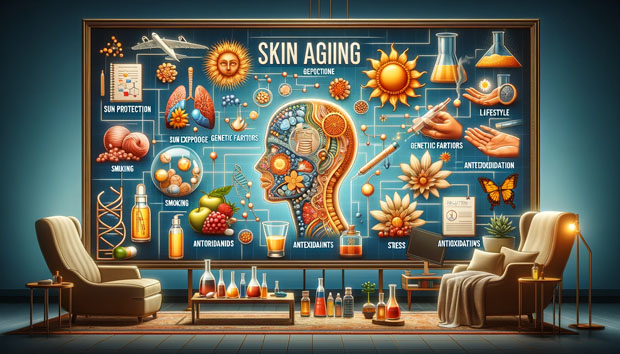Skin aging is the result of two aging processes that complement each other:
- Internal or constitutional aging is individual for each person, it is genetically programmed and occurs gradually;
- External aging is caused by external factors – it can be controlled, and it is associated with premature aging of the skin.
What are the signs of skin aging?
With age, the renewal of epidermal cells slows down.
The epidermis is thinning, and the stratum corneum, consisting of surface dead cells, thickens.
This leads to the appearance of dehydrated skin with enlarged pores and pigmentation disorders.
The dermis, which contains elastic and collagen fibers, also suffers from signs of aging.
These fibers change, and the production of hyaluronic acid decreases, which makes the skin less elastic and leads to the appearance of wrinkles.
Signs of skin aging that are exacerbated by sunlight:
- Dark spots from hyperpigmentation;
- Wrinkles;
- Skin relaxation;
- dehydration of the skin;
- Thinning of the skin;
- Actinic keratosis.
- Actinic keratoses are precancerous lesions, and their presence requires serious dermatological observation.
Actinic keratoses are local thickening of the skin covered with scales.
They manifest as age spots on areas exposed to the sun, such as the back, arms, and face.
What are the causes of skin aging?
The sunbeam
Sunlight is a major factor in skin aging.
Prolonged exposure to the sun leads to premature aging of the skin.
UV rays affect skin cells, breaking their DNA chain and thereby causing changes in cell renewal and the production of melanin, collagen, and elastin.
They contribute to the strengthening of the physiological processes of aging, which leads to the appearance of less elastic, dry, dehydrated, and wrinkled skin.
Light-skinned people will have more sun exposure earlier than people with darker skin, due to the smaller amount of melanin that performs protective functions.
Genetics
There are many differences in the phenomenon of skin aging in different people, as well as a genetic predisposition to earlier aging.
Smoking
Smoking also leads to the appearance of wrinkles due to the destruction of elastic fibers of the skin.
The skin loses its radiance, its color turns gray, and healing processes are disrupted.
Stress and pollution
Stress and environmental pollution also disrupt cell functions, slowing down cell renewal and destroying hyaluronic acid, which is responsible for skin tone and hydration.
Stress and environmental pollution are associated with an increase in the secretion of free radicals — substances that are produced by the body and are responsible for the aging processes and cell damage.
Sedentary lifestyle
A sedentary lifestyle, poor nutrition with low content of antioxidants and essential fatty acids, alcohol, and lack of sleep also play a role in the aging process of the skin.
Hormones
Female sex hormones play an important role in moisturizing the skin. This is why the skin becomes drier during menopause.
How to protect our skin from aging?
- Protection from sunlight and regular use of sunscreens helps to avoid accelerating the process of premature aging;
- Skin hydration – proper hydration is an effective preventive measure that can prevent accelerated aging;
- taking enough fluids, regularly throughout the day;
- Antioxidant products help prevent skin aging;
- Balanced and varied nutrition;
- Quit smoking – after quitting smoking, the skin quickly regains its appearance and elasticity;
- cope with stress;
- A complete dream.


Leave a Reply